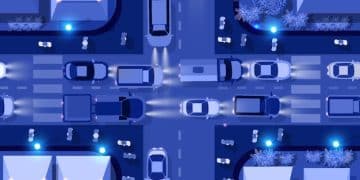How US 5G Expansion Will Revolutionize Autonomous Vehicles by 2026

The expansion of 5G networks across the US promises to significantly accelerate the development and deployment of autonomous vehicles by 2026, enabling faster data processing, improved connectivity, and enhanced safety features for self-driving cars.
The race to deploy fully autonomous vehicles is heavily reliant on robust and reliable communication networks. The rollout of how will the expansion of 5G networks across the US affect the development of autonomous vehicles by 2026 is poised to be transformative, offering unprecedented speed and bandwidth capabilities.
Understanding the 5G Revolution and Its Potential
5G technology represents a significant leap forward in wireless communication. Its high bandwidth and low latency are crucial for applications that demand real-time data processing and reliable connectivity. Let’s explore the fundamentals of 5G and its potential impact.
What is 5G?
5G is the fifth generation of wireless technology, designed to offer faster speeds, lower latency, and greater capacity than its predecessors. It utilizes higher frequencies and more advanced technologies to achieve these improvements.
Key Benefits of 5G for Autonomous Vehicles
5G offers several key benefits that are particularly relevant to autonomous vehicles, including:
- Ultra-low latency: Reduces the delay in data transmission, enabling quicker responses from vehicles.
- High bandwidth: Allows for the transmission of large amounts of data, supporting advanced sensor systems.
- Enhanced reliability: Ensures consistent connectivity, even in densely populated areas.
With these advantages, 5G can facilitate safer and more efficient autonomous driving experiences.
Current State of 5G Deployment in the US
Understanding the current state of 5G deployment in the US is crucial for evaluating its near-term impact on autonomous vehicles. While progress has been made, challenges and regional disparities persist. Let’s examine the ongoing efforts to expand 5G coverage and infrastructure across the country.
Major Telecom Providers and Their Rollout Plans
Several major telecom providers, including Verizon, AT&T, and T-Mobile, are actively deploying 5G networks across the US. Their plans vary in terms of coverage, speed, and technology used.
Challenges in 5G Deployment
Despite the potential, 5G deployment faces several challenges, such as:
- Infrastructure costs: Building out the necessary infrastructure requires significant investment.
- Spectrum availability: Access to sufficient spectrum is essential for widespread deployment.
- Regulatory hurdles: Navigating regulatory processes can delay deployment timelines.
Overcoming these challenges is essential for realizing the full potential of 5G in the US.

How 5G Enhances Autonomous Vehicle Capabilities
5G technology significantly enhances the capabilities of autonomous vehicles, driving improvements in safety, efficiency, and overall performance. Let’s delve into specific areas where 5G plays a crucial role.
Real-time Data Processing
5G enables autonomous vehicles to process vast amounts of data in real-time. Faster data processing ensures quicker decision-making and more responsive vehicle control.
Enhanced Sensor Capabilities
With 5G, autonomous vehicles can leverage advanced sensor systems, including:
- High-resolution Cameras: Capture detailed images of the surrounding environment.
- LiDAR: Use laser technology to create 3D maps of the vehicle’s surroundings.
- Radar: Detect objects even in adverse weather conditions.
Vehicle-to-Everything (V2X) Communication
5G facilitates V2X communication, allowing vehicles to communicate with each other, infrastructure, and other road users. This communication is critical for:
- Cooperative Driving: Vehicles can coordinate their movements to improve traffic flow and safety.
- Traffic Management: Infrastructure can provide real-time traffic updates to vehicles.
- Emergency Response: Vehicles can automatically alert emergency services in the event of a crash.
These enhanced capabilities can significantly improve the safety and efficiency of driverless cars.
Potential Roadblocks and Mitigation Strategies
While the integration of 5G and autonomous vehicles holds immense promise, there are potential roadblocks that need to be addressed. Successfully navigating these challenges is vital to the widespread adoption of self-driving technology.
Cybersecurity Risks
As vehicles become increasingly connected, they become vulnerable to cyberattacks. Protecting autonomous vehicles from hacking and data breaches is paramount.
Data Privacy Concerns
The collection and use of data by autonomous vehicles raise significant data privacy concerns. Regulations and safeguards are needed to ensure the responsible handling of personal information.
Network Reliability
The reliability of 5G networks is critical for the safe operation of autonomous vehicles. Redundancy and backup systems are essential to mitigate the risk of network outages.
Addressing these roadblocks will pave the way for a secure and reliable autonomous driving future.

Economic and Societal Impact of 5G-Enabled Autonomous Vehicles
The widespread adoption of 5G-enabled autonomous vehicles is expected to have profound economic and societal impacts. From transforming transportation to reshaping urban landscapes, the ripple effects will be far-reaching.
Job Creation and Transformation
The development, deployment, and maintenance of autonomous vehicles will create new job opportunities. However, it may also lead to job displacement in certain sectors, such as truck driving.
Urban Planning and Infrastructure Development
Autonomous vehicles could revolutionize urban planning, reducing the need for parking spaces and altering traffic patterns. Smart infrastructure, such as connected traffic lights and sensors, will be essential.
Accessibility and Mobility for All
Autonomous vehicles have the potential to enhance accessibility and mobility for individuals with disabilities, the elderly, and those living in underserved areas.
The transformative potential of autonomous vehicles extends far beyond transportation.
Looking Ahead: Autonomous Vehicles in 2026
By 2026, the integration of 5G and autonomous vehicles is expected to be well underway, with significant advancements in technology, infrastructure, and regulatory frameworks. Predictions for the future include increasingly autonomous driving capabilities in commercial fleets and private vehicles and further development based on the expansion of 5how will the expansion of 5G networks across the US affect the development of autonomous vehicles by 2026
Predictions for Autonomous Vehicle Technology
Major advancements are expected in self-driving technology, including:
- Enhanced AI and Machine Learning: Improve the ability of vehicles to perceive and understand their surroundings.
- Advanced Sensor Fusion: Combine data from multiple sensors to create a more complete picture of the environment.
- Improved Safety Systems: Reduce the risk of accidents and enhance passenger safety.
Regulatory and Policy Developments
Governments are expected to establish comprehensive regulatory frameworks to govern the testing and deployment of autonomous vehicles, addressing issues such as:
- Safety Standards: Ensure that autonomous vehicles meet rigorous safety requirements.
- Liability and Insurance: Determine who is responsible in the event of an accident.
- Data Privacy: Protect personal information collected by autonomous vehicles.
Challenges and Opportunities
The path forward for 5G-enabled autonomous vehicles is filled with both challenges and opportunities. Continued investment in research and development, collaboration between industry and government, and engagement with the public will be essential for realizing the full potential of this transformative technology.
| Key Point | Brief Description |
|---|---|
| 🚀 5G Revolution | Faster speeds and lower latency enhance autonomous vehicle capabilities. |
| 🚧 Deployment Challenges | Infrastructure costs and spectrum availability can hinder 5G expansion. |
| 🚗 V2X Communication | Vehicles coordinate movements via 5G, improving traffic flow and safety. |
| 🛡️ Cybersecurity | Protecting autonomous vehicles from hacking is essential for their adoption. |
Frequently Asked Questions
▼
5G’s low latency allows for quicker responses, reducing reaction times in critical situations and preventing accidents.
▼
High infrastructure costs, limited access to fiber optic cables, and lower population density are key challenges.
▼
Yes, but 5G significantly enhances their capabilities, especially in complex urban environments, improving safety and efficiency.
▼
Autonomous vehicles may reduce transportation costs by optimizing routes, decreasing fuel consumption, and minimizing accidents.
▼
Ethical considerations include accident liability, data privacy, and ensuring fair access to autonomous transportation for all members of society.
Conclusion
The convergence of 5G technology and autonomous vehicles holds immense potential to revolutionize transportation and society. While challenges remain, the promise of safer, more efficient, and more accessible mobility is within reach, dependent on how will the expansion of 5G networks across the US affect the development of autonomous vehicles by 2026





